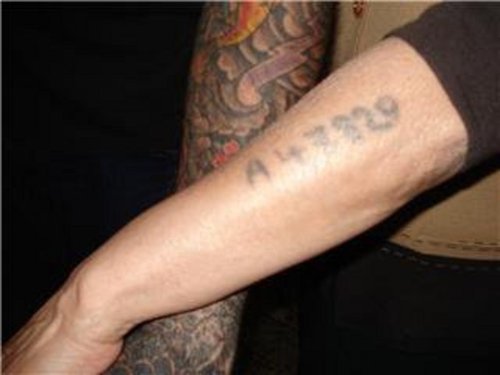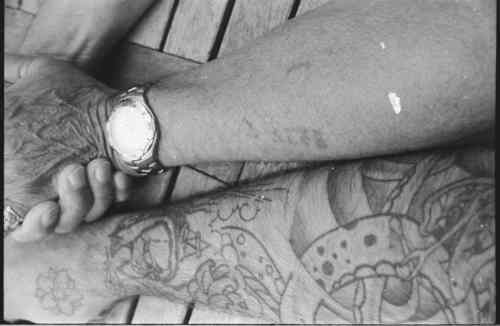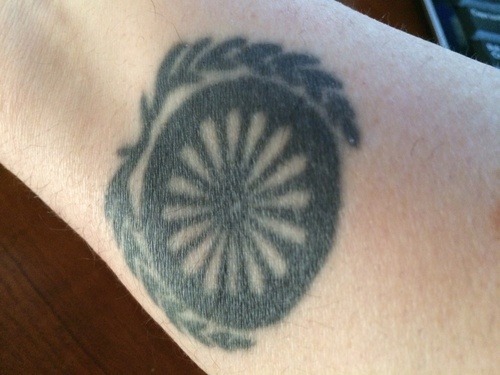
Gypsy Tattoos - Holocaust Survivors honored by the New Generation
Gypsy Holocaust Survivors tattoos by Daniela Stolfi-Tow Many of my family members were killed in Auschwitz and Dachau. One of my famil...
Latest Articles
Sunday, July 3, 2016
Thursday, June 30, 2016
Gypsy Holocaust Survivors tattoos by Daniela Stolfi-Tow
Many
of my family members were killed in Auschwitz and Dachau. One of my family members, Romani Rose, runs the Sinti and Roma Documentation Center in Manheim Germany that tells the histsory. He is one of many members of my family who have been activists for Sinti and Roma even building the first memorial site.
My surviving family members like my grandparents and Great Aunts/Uncles still have the tattoos. for them, tattoos had a very different meaning.
My surviving family members like my grandparents and Great Aunts/Uncles still have the tattoos. for them, tattoos had a very different meaning.

My grandmother and brother comparing tattoos.
My Grandmother was in Auschwitz. Her tattoo used to have a "Z" on it which was how Gypsies were identified in the camps. (Z for Zigeuner which means Gypsy in German) But for fear of discrimination she had it changed to an "A" which is how the Jews were identified.

This is my Papu who recently passed away. He was a victim of Mengela at Auschwitz and underwent the water tests.

This is a tattoo the younger generation get to honor Sinti

The Romani Chakra wheel.
This is the tattoo that we all wear now on our forearms, to honor those in our family who survived and those who didn't...to say we will never forget, your memories are alive in us. The wheel was adopted in 1971 at the First World Romani Congress as the official symbol of the Roma (“Gypsy”) people, and it resembles a Hindu Chakra wheel to honor our Indian heritage. It is meant to symbolize the wheel of a Vardo, or Wagon and has 16 spokes. (8 core values spreading outward toward fellow man and the 8 respective values being returned in kind to the Roman)
This is how we honor those who have fallen by saying NEVER AGAIN!
-Daniela Stolfi-Tow (Bamberger family, Mannheim and Heidelberg Germany)
http://twitter.com/romanigypsy
Saturday, April 25, 2015
Sinti mother and daughter Sita and Daniela have created the first Sinti cooking channel THE GYPSY KITCHEN!
Sita and Dani are Sinti who have traveled the world. They will be cooking not only their own family recipes with German influences, but recipes from Romani in every country, tracing the route of their migration from India all the way to the US.
"You can learn so much about people through their food. We decided that a good way to teach people the true origin and culture of Romani, was through our kitchen because good food is universal."
Sita Bamberger from Heidelberg Germany, is the niece of Romani Rose, a Romany activist and head of the Central Council of German Sinti and Roma. She is also the neice of famous Romani boxer and activist Jakob Bamberger. Her parents were survivors of the holocaust. Sita and Dani have carried on as activists for Sinti causes. Dani set precedence becoming the first Gypsy to receive a college scholarship as a recognized minority due to the work of Ian Hancock who traced Romani routes to India, allowing Gypsy students to choose Indian as their ethnicity.
"The kitchen is the heart of our home. Cooking is our passion. By welcoming you into our kitchen we hope you will better understand our culture and begin to see that most of what you have known about our people has been a total lie." said Dani.
The pair warn that Gypsy cooking isn't for everyone
"We rarely measure. We don't follow recipes. We are impulsive. We go on taste. Gypsy cooking historically is about using what is available. During the war, after the war, my family had to make due. This is how we learned to cook." said Sita
Dani explains why they use the term GYPSY
"The term Gypsy as considered discriminatory by most Romani. We are a guarded culture. This act has deprived the world of our rich culture and history, and made us the unfair target of discrimination and misconception.
Right now we are telling people Gypsy is racist and not to call us that, then go after them for using the word in their business or to describe something. It is confusing people.
And now with the internet, there is a lack of factual information. Even worse is people profiting off the fantasy. Sadly most of the people who have books out, shows, fashion lines, they are all gadje (outsiders).
My mom was very against using the term Gypsy because of the racial violence my family has survived. This violence is alive and well in many countries largely due to harmful stereotypes.
THIS IS why education is more important than ever. And the internet gives us a very unique opportunity to do this.
Educated Sinti need to use the same means of communication putting out the bad information. This is the Search engines. We have to replace the bad with good.
But if I say Sinti or Roma, people don't know what that is. That is how much work we still have to do. Those looking for information search "Gypsy" and what are they finding is reality shows, spell books and gadje selling things.Our goal is to make a presence, establish ourselves in this new online world and get people to listen. Only then can we start getting them to understand everything they have known about us as been a lie, to finally see us as people and not as a way of life."
Thursday, February 21, 2013
 Hindus
stress that Europe should work aggressively to end statelessness, thus
improving the plight of stateless who suffer rejection day after day.
Hindus
stress that Europe should work aggressively to end statelessness, thus
improving the plight of stateless who suffer rejection day after day.
According
to reports, hundreds of thousands of Europeans, including many children, do not
have citizenship of any of its countries. Statelessness is more prevalent
amongst most excluded and poorest. Many European Roma (Gypsies) are victims of
statelessness for no fault of theirs.
Hindu statesman Rajan Zed, in a statement in Nevada (USA)
today, said that the issue of statelessness in Europe should be urgently
addressed and stateless in Europe needed to be protected from severe and
continuous violation of their human rights.
Zed, who is President of Universal Society of Hinduism,
pointed out that access of stateless to health services, employment, education,
property ownership and travel was severely restricted and they faced detention
and inability to obtain identity papers.
They were denied the most basic of rights and were vulnerable to
trafficking.
Leaders of various religions/denominations, including Pope,
should also come forward and advocate on behalf of the stateless and highlight
their plight as religions told us to help the helpless, Rajan Zed stated.
Zed
further said that European countries should reach out to the vulnerable groups
like Roma and make sure all birth registrations were done immediately and
citizenship automatically granted at birth. They should carve out
administrative procedures for all stateless persons to acquire nationality and follow
directives of various international conventions on statelessness.
Instead
of blaming “others” like parents, other countries, stateless themselves and
history; European nations should urgently address statelessness and thus
putting an end to the sufferings of those affected, Rajan Zed added.
According
to Council of Europe Commissioner for Human Rights Nils Muiznieks, "Statelessness
is not disappearing with time, but being transmitted over generations".
Although
the stateless issue affected almost all the countries of Europe, but
significant number of stateless persons are in successor states of former
Yugoslavia, Italy, Ukraine, Russia, Estonia and Latvia; reports suggest.
United Nations High Commissioner for Refugees says
“statelessness refers to the condition of an individual who is not considered
as a national by any state”.
Saturday, July 2, 2011
Reuters) - The erection of a concrete wall between a Roma gypsy neighborhood and a main road in northern Romania has led a human rights group to accuse the town of trying to set up a ghetto.
Catalin Chereches, the 32-year-old mayor of Baia Mare, told Reuters Friday the plan was not discriminatory and the wall's height of 1.8 meters (six feet) was designed to prevent traffic accidents.
The vast majority of Romania's Roma gypsy population live on the margins of society in abject poverty and pro-democracy organizations say the state does not do enough to prevent discrimination.
"Such initiatives belong to the Nazi era," rights group Center for Legal Resources said in a letter demanding the mayor halt work on the wall and resign.
Romania's Roma gypsy population is about 550,000, according to official estimates. But rights groups put it as high as 2.5 million, making it the largest such community in Europe.
Since Romania joined the European Union in 2007, hundreds of thousands of Roma have flooded European cities, complaining of racism and poverty at home.
France's repatriation of Roma last year prompted one European Union official to recall the Nazis' persecution, overshadowed an EU summit and sparked a row between President Nicolas Sarkozy and Germany's Angela Merkel.
Roma have a long history of being persecuted and during World War Two they were targeted by the Nazis. Although estimates vary, it is thought several hundred thousand died in concentration camps alongside millions of Jews.
(Reporting by Radu Marinas; editing by Robert Woodward)
Catalin Chereches, the 32-year-old mayor of Baia Mare, told Reuters Friday the plan was not discriminatory and the wall's height of 1.8 meters (six feet) was designed to prevent traffic accidents.
"It's only aimed at protecting our citizens against car crashes," Chereches said by telephone. "It's made of coated concrete instead of wood to stop people using it to make a fire."
The vast majority of Romania's Roma gypsy population live on the margins of society in abject poverty and pro-democracy organizations say the state does not do enough to prevent discrimination.
"Such initiatives belong to the Nazi era," rights group Center for Legal Resources said in a letter demanding the mayor halt work on the wall and resign.
"The idea to separate a community with severe social problems ... amounts to institutionalized racism."
Romania's Roma gypsy population is about 550,000, according to official estimates. But rights groups put it as high as 2.5 million, making it the largest such community in Europe.
Since Romania joined the European Union in 2007, hundreds of thousands of Roma have flooded European cities, complaining of racism and poverty at home.
France's repatriation of Roma last year prompted one European Union official to recall the Nazis' persecution, overshadowed an EU summit and sparked a row between President Nicolas Sarkozy and Germany's Angela Merkel.
Roma have a long history of being persecuted and during World War Two they were targeted by the Nazis. Although estimates vary, it is thought several hundred thousand died in concentration camps alongside millions of Jews.
(Reporting by Radu Marinas; editing by Robert Woodward)








